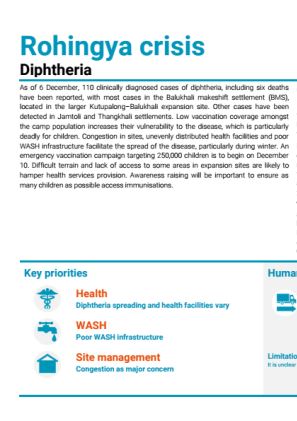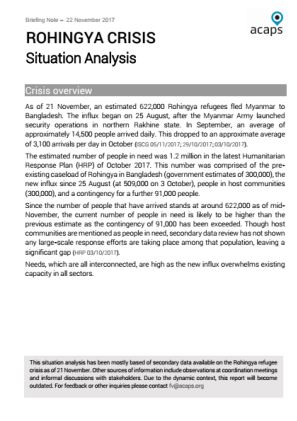-
Countries
-
Data and Analysis
-
Special Focus
-
Crisis Responses
Bangladesh
Bangladesh
Suivi des PDI
Mouvements de déplacement
426,000
IDMC 2023
cycle de collecte de données
À propos Bangladesh
IOM Bangladesh Needs and Population Monitoring (NPM) tracks population numbers, movements and needs to inform the Rohingya humanitarian response in Cox Bazar. IOM Bangladesh Needs and Population Monitoring (NPM) is part of IOM’s global Displacement Tracking Matrix (DTM) programming. DTM is IOM’s information management system to track and monitor displacement and population mobility. It is designed to capture, process, and disseminate information to provide a better understanding of the movements and evolving needs of displaced populations, whether on-site or en route regularly and systematically. IOM Bangladesh NPM was first launched in Cox’s Bazar district in early 2017 and has consistently been a key data provider in the Rohingya humanitarian response. Access the NPM Portal for the most recent products.
IOM’s Needs and Population Monitoring (NPM) unit works to support evidence-based humanitarian decision-making and prioritization by tracking needs and vulnerabilities among both Rohingya and the host communities in Cox’s Bazar. Through NPM’s broad information management framework, service providers can access and make use of comprehensive data and analysis on the needs and vulnerabilities of affected populations, promoting more informed and nuanced humanitarian programming. NPM successfully partners and cooperates with the Inter-Sector Coordination Group (ISCG), various sectors, such as Shelter and Camp Coordination and Camp Management (SCCCM), and humanitarian partners, particularly through designing and conducting a wide range of assessments and providing ad-hoc data collection services, as well as technical information management and GIS with Drone support. In addition. Since 2018, REACH Initiative and NPM closely collaborating in the implementation of the Multi-Sectoral Needs assessments in Rohingya refugee camps and host communities. NPM has also provided field and contextual expertise to Ground Truth Solutions and Translators without Borders. These partnerships serve to strengthen NPM as a key information provider of the response.
Since 2018, IOM, with funding from the European Union, established the Displacement Tracking Matrix Regional Evidence for Migration Analysis and Policy (DTM REMAP) project, to strengthen the evidence-based formulation and implementation of humanitarian and development policy and programming on human mobility, migration, return and displacement in Bangladesh. Under DTM REMAP, IOM Bangladesh conducts various activities in a variety of districts in Bangladesh including: i) Baseline Mobility Assessments (BMA) to inform on numbers and locations of Bangladeshi internal and international migrants; ii) Survey on Drivers of Migration (SDM) to improve the understanding of the drivers of out-migration among Bangladeshi (potential) migrants; iii) Returnee Longitudinal Studies (RLS) to monitor the sustainability of return and needs and vulnerabilities of returnees; iv) Community Based Needs Assessments (CBNA) to inform on characteristics, needs and vulnerabilities of Bangladeshi migrants and their communities.
Bailleurs de fonds
- European Union
- Australia
- PRM
- DFID
Bangladesh — NPM ACAPS Analysis Hub Report — Rohingya Crisis Impact of Cyclones Report (April 2018)
This document presented the lessons learned about the impact of cyclones in Bangladesh and specifically Cox’s Bazar district. Documentation on the specific impact or lessons from the impact of cyclones on the Rohingya population in Cox’s Bazar is limited.
Bangladesh — NPM ACAPS Analysis Hub Report — Rohingya Crisis Cyclones Background Report (March 2018)
Organisations working on the Rohingya response are preparing for the cyclone season. This brief provides background on cyclones in Bangladesh and an overview of their impact, to put the emergency preparedness planning into a wider perspective.
Bangladesh — NPM ACAPS Analysis Hub Report — Rohingya Crisis Pre-Monsoon Review (March 2018)
Humanitarian actors expect operations to be seriously impacted during the rainy season in Cox’s Bazar.
Bangladesh — NPM ACAPS Analysis Hub Report — Rohingya Crisis Pre-Monsoon Review Summary Report (March 2018)
The rainy season is expected to have a serious impact on life-saving services and ongoing humanitarian aid in Cox’s Bazar.
Bangladesh — NPM Site Maps — Atlas of Camps (14 February 2018)
The following document includes a topographic atlas, as of 14 February 2018, of the following sites: Camps 1E, 1W, 2E, 2W, 3-7, 8E, 8W, 9-20, Chakmarkul, Jadimura, Kutupalong (RC), Leda A/B/C/D, Leda Ms, Nayapara EXP, Nayapara RC, Shamlapur, and Unchiprang.
Bangladesh — NPM Site Map Camps 14,15,16, Chakmarkul, Shamlapur, and Unchiprang (14 February 2018)
This map provides drone imagerary overview of camps 14,15,16, Chakmarkul, Shamlapur and Unchiprang as of 14 February 2018.
Bangladesh — NPM Site Map (14 February 2018)
This map provides drone imagery overview of the sites in Leda, Nayapara, and Jadimura areas in Teknaf, Cox's Bazar (Chittagong), as of 14 February 2018.
Mar 12 2018
Bangladesh — NPM Site Map (14 February 2018)
Bangladesh — NPM Site Map Kutupalong Expansion (14 February 2018)
This map provides drone imagery overview of the Kutpalong Expansion in Ukhia, Cox's Bazar, Chittagong, as of 14 February 2018.
Bangladesh — Site Profiles, Round 8 (February 2018)
Following an outbreak of violence on 25 August 2017 in Rakhine State, Myanmar, a new massive influx of Rohingya refugees to Cox’s Bazar, Bangladesh started in late August 2017.
Bangladesh — NPM Site Overview Jamtoli, Chakmarkul, Unchiprang, Shamlapur, Teknaf, Kutupalong (2 February 2018)
This document displays the site outlines for the following displacement sites: Jamtoli, Chakmarkul, Unchiprang, Shamlapur, Teknaf, and Kutupalong/Balukhali Expansion Site – Kutupalong RC.
Bangladesh — Rohingya Crisis — Host Communities Review (January 2018)
The Rohingya influx in Cox’s Bazar has put pressure on the district’s Bangladeshi community, particularly in the upazilas of Teknaf and Ukhia where the Rohingya now constitute at least one third of the total population.
Bangladesh — Displacement Dashboard Round 7 (11 December 2017)
From 11 November to 5 December, 1,635 locations in collective sites and host communities were assessed by NPM enumerators.
Bangladesh — Site Profiles, Round 7 (December 2017)
From 11 November to 7 December, 1,635 locations in collective sites and host communities were assessed by NPM enumerators.
Bangladesh — Needs and Population Monitoring Report 7 (December 2017)
From 11 November to 7 December, 1,635 locations in collective sites and host communities were assessed by NPM enumerators.
Bangladesh — Rohingya Crisis Report — Diphteria (11 December 2017)
As of 6 December, 110 clinically diagnosed cases of diphtheria, including six deaths have been reported, with most cases in the Balukhali makeshift settlement (BMS), located in the larger Kutupalong–Balukhali expansion site. Other cases have been detected in Jamtoli and Thangkhali settlements.
Bangladesh — NPM ACAPS Analysis Hub Report — Rohingya Influx since 1978 (December 2017)
In the 20th century, there have been multiple waves of movement of Rohingya population from Rakhine State in Myanmar to Cox’s Bazar in Bangladesh and back. This report is a review of available literature on the Rohingya influxes into Bangladesh since 1978.
Bangladesh — Rohingya Crisis — Situation Analysis Report (22 November 2017
As of 21 November, an estimated 622,000 Rohingya refugees fled Myanmar to Bangladesh. The influx began on 25 August, after the Myanmar Army launched security operations in northern Rakhine state. In September, an average of approximately 14,500 people arrived daily.
Bangladesh – Collective sites hosting the Rohinya population (October 2017)
The following map provides an overview of the collective sites hosting the Rohinya population.
Bangladesh — Needs and Population Monitoring Report 6 (October 2017)
Following an outbreak of violence on 25 August 2017 in the Rakhine State of Myanmar, a new massive influx of Rohingya population to Cox’s Bazar, Bangladesh started in late August 2017.
Bangladesh — Needs and Population Monitoring Report 5 (September 2017)
A total of 143 locations in 85 sites were assessed between 5 and 21 September 2017. 607,735 UMNs were identified in four upazilas of Cox’s Bazar District. Among those assessed, 53% are women and girls.
Bangladesh — Site Profiles, Round 5 (September 2017)
This document includes the site profiles for the following locations: Balukhali MS, Unchiprang/Raikhong, Shamlapur, Mainnerghona, Leda MS, Kutupalong MS, Jamtoli, Hakimpara, Barmapara.
Bangladesh — Needs and Population Monitoring Report 4 (July 2017)
The National Strategy on Myanmar Refugees and Undocumented Myanmar Nationals (UMN) formulated by the Government of Bangladesh highlights the fact that more than 300,000 Rohingyas have crossed the border and are living in Bangladesh.
Bangladesh — Needs and Population Monitoring Report 3 (June 2017)
A total of 53 sites were assessed. 151,000 UMNs were identified in 2 upazilas of Cox’s Bazar district. An additional 9 sites, with a population of 8,110 according to NPM Round 2 (April 2017) were not assessed in this round due to limited access. Among those assessed, 53% are women and girls.
Bangladesh — Needs and Population Monitoring Report 2 (April 2017)
A total of 62 sites were assessed. 150,000 undocumented Myanmar nationals (UMNs) in 300,000 households were identified in 2 upazilas of Cox’s Bazar district, including 74,000 new arrivals since October 2016. Among those assessed, 49.9% are women and girls.


























